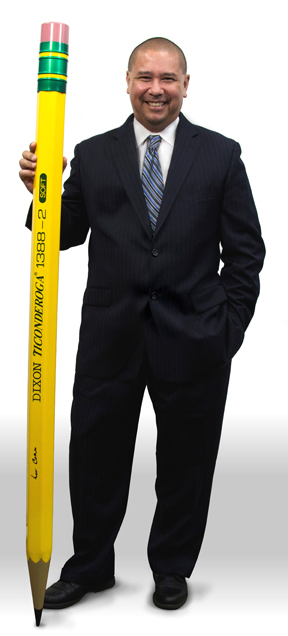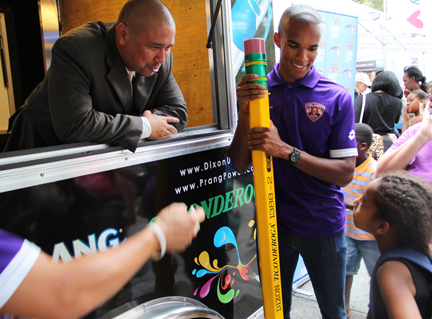
Dixon Ticonderoga’s pencil sales look sharp, even in today’s digitally connected world
On the TV trivia show “Jeopardy!,” you might expect this question: It’s one of America’s oldest companies that manufactures pencils, crayons and art supplies and traces its roots back to the very foundation of the United States.
If you answered, “What is the Dixon Ticonderoga Company?” you’d be correct.
Manufacturer and entrepreneur Joseph Dixon founded the Joseph Dixon Crucible Company in Salem, Massachusetts in 1827. He is credited with producing the first pencil made in the U.S. in 1829 and developing pencil automation. In 1982, the Joseph Dixon Crucible Company merged with the Bryn Mawr Corporation, a Pennsylvania transportation and real estate company with operations dating back to 1795. The resulting entity became the Dixon Ticonderoga Company, named after Joseph Dixon and the company’s oldest brand-name pencil, the Ticonderoga.
With a world that has moved into such a technological state, one might think that pencils are waning in popularity. But nothing could be further from the truth.
“Pencils are timeless. They are uncomplicated. They don’t require electricity. Once you erase a mistake, it’s gone,” says Timothy Gomez, the Lake Mary, Florida-based company’s CEO and vice chairman of the board. “Despite rumors to the contrary, tablets have not negatively affected our pencil sales. In fact, we read in a Chicago newspaper that students take notes on their phones and then transcribe them in pencil for studying. That, in a nutshell, is why pencils continue to rule in the writing instrument world.”
Gomez says Dixon Ticonderoga pencils lead the industry due to the company’s quality controls and demand for perfection in both manufacturing and customer delivery. “We have quite a large promotional products channel,” Gomez says. “And we work hard to be top of mind with distributors worldwide by having a strong presence at industry shows, building personal relationships and using clever outreach strategies to remind them as much as possible of the quality of our products and our quick response time.”
The company’s Macon, Georgia location handles promotional production and Gomez generously praises his employees. “I love how responsive they are, and how passionate they are about serving our growing customer base, which includes small consumers and large companies that require millions of pencils,” Gomez says. “It takes flexibility to adapt to such a variety of customer needs, so we pride ourselves on managing that complexity in the promotional products marketplace.”
Keeping the company headquarters in Florida (and choosing Lake Mary) was a no-brainer, according to Gomez, who raves about the business-friendly environment, top school district and high-caliber workforce—and sports teams. “Our employees’ quality of life is important to us, and as Orlando Magic fans, the thought of living in another NBA market was just not acceptable.”
As the CEO of a global company, Gomez is often on airplanes, which gives him a lot of time to ponder the challenges Dixon Ticonderoga faces. A self-proclaimed “systems guy,” Gomez spends much of his time on the company’s manufacturing and delivery systems and product and manufacturing innovations. “We are constantly challenging ourselves to build a better pencil and to expand our product base. From a commercial perspective, we are re-inventing ourselves with new product offerings in green technology and renewable energy.”
But the product that most people associate with the brand is the No. 2 yellow pencil. Many people believe that Dixon Ticonderoga pencils were originally painted yellow because it was a royal color that indicated the highest quality graphite from China.
Not true, says Gomez. “Whoever started this rumor is probably laughing that it actually caught on. The first graphite mines were in Fort Ticonderoga, New York, not China. What is very real is that if you look at all of our pencil brands, such as Ticonderoga, Oriole and Dixon, you will find that our distinctive color is imitated by those who hope to confuse consumers.”
Gomez believes donating school supplies through the Kids in Need Foundation (KINF) is the company’s most important mission—next to providing quality writing instruments. KINF is a charitable organization that provides school supplies to children who don’t have access to them; PPAI has also supported this organization in a variety of ways since 2007. “Who knows what poets, writers or illustrators are born with every pencil we donate? I think about that every time we load a pallet of products destined for those kids,” he says.
Dixon Ticonderoga By The Numbers:
- Manufactures over one billion pencils per year
- 50 million students use its products every day
- Donates $1.5 million in product and teacher grants each year
- More than $1 million in artwork is displayed in the company art gallery
- The company dates back 220 years
- The Ticonderoga pencil is more than 100 years old
- Recently added 20 new employees due to growth and company acquisition
- Offers four categories of promotional products: crayons, pencils, markers and pens
- The company doubled in size in less than seven years after the last recession in 2008



